 © Lourens Smak/Alamy
© Lourens Smak/Alamy
|
Mobile subscriptions reach 4 billion
Fixed-line market penetration remains comparatively low in most developing countries, at an average of 13 per cent at the end of 2007, even though the developing world accounted for 58 per cent of the world’s 1.3 billion fixed-telephone lines in that year. This segment of the market showed a decline in developed countries and just a slight increase in some developing countries. On the whole, fixed-line penetration worldwide stagnated in 2007.
Mobile penetration, however, continued to show high growth rates and reached an estimated 61 per cent of the world’s population (or 4 billion subscriptions) at the end of 2008. More than 70 per cent of the world’s mobile subscribers were in developing countries at the beginning of 2008 (see Figure 1, left chart). Africa remains the region with the highest growth rate (32 per cent between 2006 and 2007). Its mobile penetration of 28 per cent is comparable with the 37 per cent in Asia, 72 per cent in the Americas, and 110 per cent in Europe at the end of 2007 (see Figure 1, right chart).
As the global mobile penetration reaches 61 per cent, in theory this implies that every second person owns or uses a mobile phone. However, the statistic needs some clarification. Double counting takes place when individual consumers subscribe to more than one service.
|
Figure 1 — A snapshot of the mobile sector, worldwide and by region
|
|
Worldwide mobile subscribers
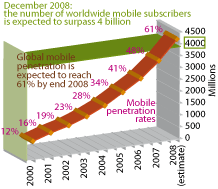
|
Mobile subscribers per 100 population, 2007
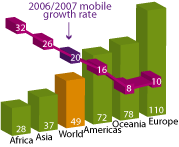
|
Source: ITU World Telecommunication/ICT Indicators Database.
|
Also, operators’ methods for counting active prepaid subscribers vary, often inflating the actual number of people that use a mobile phone. On the other hand, some subscribers, particularly in developing countries, share their mobile phones with others. This, for instance, has often been cited as the success story of Grameen Phone in rural Bangladesh.
Despite high growth rates in the mobile sector, major differences in mobile penetration rates still exist between regions and within countries, particularly urban versus rural areas. The impressive growth in the number of mobile subscribers is mainly due to developments in some of the world’s largest markets. The so-called BRIC countries — Brazil, the Russian Federation, India and China — are expected to have an important impact in terms of population, resources and global share of GDP (gross domestic product). These countries alone accounted for over 1.3 billion mobile subscribers at the end of 2008.
Broadband expands, but divisions remain
ITU’s Internet and broadband data suggest that more and more countries are going high-speed. By the end of 2007, more than 50 per cent of all Internet subscribers had a high-speed connection. Dial-up is being replaced by broadband across developed and developing countries. Already, in Chile, Senegal and Turkey, over 90 per cent of all Internet subscribers have broadband.
But major differences in penetration levels remain. While fixed broadband penetration stood at less than 1 per cent in Africa, it had reached much higher levels in Europe (16 per cent) and the Americas (10 per cent) by the end of 2007. The difference is also reflected in the regional distribution of total broadband subscribers. The vast majority of developing countries still lag behind (see Figure 2).
|
Figure 2 — The broadband divide
|
|
Mobile broadband subscribers
per 100 people
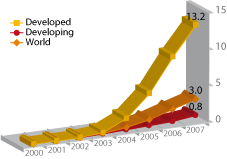
|
Fixed broadband subscribers
per 100 people
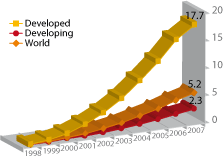
|
Note — Mobile subscribers with access to data communications at broadband speeds (minimum of 256 kbit/s).
Source: ITU World Telecommunication/ICT Indicators Database.
|
The good news is that some developing countries are showing signs of sustained broadband subscriber growth — particularly Brazil, the Russian Federation, India and China.
Mobile broadband
The number of mobile broadband subscribers reached 167 million at the end of 2007, driven by 18 per cent growth since 2006. There is intense competition among technologies, such as 2.5G and 3G, as well as the emerging high-speed packet access (HSPA), WiMAX, and long-term evolution (LTE). Recent estimates indicate that HSPA subscribers worldwide have topped the 50 million mark, rising from just 11 million in 2007.
But the global economic downturn may slow the rapid move to 3G and other new technologies. Unexpected financial losses, for example, led Thailand’s largest fixed-line operator TT&T to suspend a USD 1.5 billion 3G investment plan in October 2008. In the Russian Federation, the credit lock-down appeared to signal curtailed investment in WiMAX networks; new operators now might have to struggle to secure customers and cash flow to support their capital-intensive networks. Nevertheless, many developing and emerging countries remain on track to license 3G and WiMAX operators.
Equipping customers with functional and affordable handsets will help boost the adoption of mobile broadband. For example, Apple's introduction of the 3G iPhone has shown that consumer habits and expectations are shifting, and a new generation of customers has emerged for whom always-on, high-bandwidth connectivity is the norm. From simple Internet browsing and e-mail to mobile banking, mobile shopping, mobile VoIP and mobile television — broadband applications are likely to revolutionize the mobile marketplace.
The shift to an all-IP environment
The rise of voice-over-Internet-protocol (VoIP) services is probably the best example of the move to an “all-IP” environment. VoIP services have continued to grow strongly over the past two years, although at a slower growth rate than in 2005. More importantly, it is steadily replacing traditional public switched telephone network (PSTN) lines in many developed, and in some developing, countries.
In France and Japan, about one-third of all fixed lines were VoIP lines at the end of 2007. According to some market analysts, the global number of VoIP subscribers reached 80 million in 2008, of whom business users constitute an increasing share. The regional distribution of subscribers varies, depending on the cost of traditional fixed-line communications as well as the regulatory treatment of VoIP and of the international gateway for PSTN long-distance calls.
Skype, the most frequently cited example of a global VoIP provider, had 196 million registered users in March 2007, up from 95 million in 2006. ON World predicts that by 2011, there will be 100 million mobile VoIP users. And Skype is expected to have 25 per cent of the world’s VoIP market.
Regulatory tools are needed to help fine-tune market conditions so that VoIP can grow to its full potential. Some of the issues which regulators and policy-makers can address include peering arrangements among VoIP providers, interconnection agreements with other voice service providers, numbering reform (including number portability) and legalizing both VoIP provision and use where these are banned.
Changes in regulatory practice
 © Bill Bachmann/Alamy
© Bill Bachmann/Alamy
|
The first wave of telecommunication reform in developing countries, starting in the late 1990s, aimed to create more transparent and stable legal and regulatory frameworks, with an emphasis on establishing national regulatory authorities and opening certain market segments, such as mobile voice, to competition. The goal was to attract investment and make progress towards universal access to basic telecommunication services.
Drastic changes in the sector have since flowed from technological innovation, convergence of services, and growing competition. These changes may now require a further regulatory shift in order to open more market segments to competition, as well as to update licensing and spectrum management practices and foster growth in broadband networks and converged services. A rise in competition and new service providers will also require an enhanced focus on dispute resolution.
|
Figure 3 — The number of regulatory authorities, globally and by region
|
|
Regulatory agencies world (cumulative)
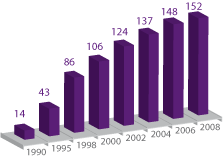
|
Percentage of regulators in each region
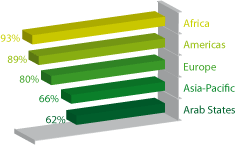 |
Source: ITU World
Telecommunication Regulatory Database.
|
As of October 2008, 152 countries had created national regulatory authorities for their ICT and telecommunication sectors (see Figure 3). Africa now has the highest percentage of countries with a separate sector regulator (93 per cent) followed by the Americas (89 per cent), Europe (80 per cent), Asia-Pacific (66 per cent) and the Arab States (62 per cent). Two new ICT regulators have been created since 2007: the Regulatory Authority for Posts and Telecommunications in Guinea, and the Vanuatu Independent Telecommunications Regulator.
During much of 2008, several governments focused on strengthening their regulatory agencies. In Europe, for example, the Hungarian regulatory authority was given greater responsibility over spectrum policy matters — and consumer protection was strengthened through the introduction of legislative changes. In Namibia, the Ministry of Information and Communications Technology was created to revamp all ICT-related policies and legislation. And in Tunisia, a new telecommunication law was passed in January 2008, providing additional investigatory, dispute-resolution and sanction powers to the regulatory authority.
Private ownership and competition
Privatization
|
Figure 4 — Ownership of the fixed-line incumbents, globally, and by region
|
|
Status of fixed-line incumbents, worldwide, 1991–2008
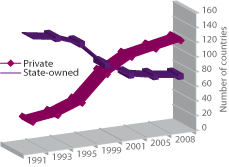
|
Privately-owned fixed-line incumbents, in percentage by region, October 2008
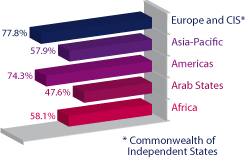
* Commonwealth of
Independent States |
|
|
|
Source: ITU World Telecommunication/ICT Indicators Database. |
By mid-2008, some 125 ITU Member States had one or more privately-owned, or partially privatized, national fixed-line incumbent (see Figure 4). The regions with the highest percentage of private ownership are Europe (some 78 per cent), the Americas (74 per cent), and Asia-Pacific and Africa both at some 58 per cent.
Many countries in Africa have embarked on the privatization path. The Government of Kenya successfully sold 51 per cent of Telkom Kenya to France Telecom for USD 390 million in December 2007. In Ghana, the Parliament approved the sale of incumbent, Ghana Telecom, to Vodafone in August 2008.
Meanwhile, Algeria, Guinea and Mali have announced plans to privatize their incumbent operators in 2009. While it is hard to predict the long-term impact the global economic and financial crisis will have on the ICT sector, there is certainly the possibility that it will affect the flow of capital into privatizations in developing countries.
Competition
Markets are steadily opening to competition, with those for Internet and mobile services being the most competitive. Only 40 countries had authorized competition in the provision of basic telecommunication services in 1997, but a decade later the number had risen to about 110 countries.
Continued reforms in the Arab States have led to more liberalization in the sector. Qatar opened its telecommunication market to competition in 2008. In Oman, the regulatory authority launched a process in August 2008 to license a second fixed-line national operator. The future licensee will be granted broadband wireless spectrum rights (for 15 years) in addition to authorization for national, local access and international network facilities (submarine cable and landing station rights) for the next 25 years.
Egypt also plans to license its second fixed-line operator by early 2009. And the Government of Rwanda launched a public tender in 2008 to select a third national operator, following the end of an exclusivity period enjoyed by the two incumbents, Rwandatel and MTN Rwandacel. The third operator will be granted both fixed and mobile licences, with terms of 15 years. In Malawi, a third GSM licence was awarded in the first half of 2008.
In the Asia-Pacific region, the Chinese government is planning to issue three 3G broadband licences following an industry restructuring. India announced it will hold an auction for at least five 3G broadband mobile licences before the end of 2008. And in Viet Nam, seven operators are reportedly competing for four 3G licences to be granted by the Ministry of Information and Communications.
In the Americas, Industry Canada announced plans in June 2008 for an “advanced wireless service” spectrum auction. A total of 105 MHz of radio spectrum will be open for bidding, including 40 MHz reserved for new market entrants. In Ecuador, the two foreign-owned mobile operators, América Móvil’s Porta and Telefónica’s Movistar, saw their licences extended for 15 years. Both operators, however, had to pay a higher price for their extensions than they had paid for their initial concessions. Meanwhile, the Brazilian regulator ANATEL successfully auctioned 3G licences at the end of 2007, providing four in each of the 11 licensing areas and generating USD 3 billion in revenues. By 2016, the new Brazilian licensees are expected to provide mobile broadband Internet access to more than 3800 municipalities, covering some 17.3 million people for the first time.
Looking to the future
With more than 2 billion potential users still unconnected to telecommunication networks, developing and emerging markets are likely to be the main drivers of growth in subscribers and revenues over the next few years. Even if the financial crisis slows down the deployment of new networks and the transition to more advanced technologies, the growth of subscribers is expected to continue.
|


